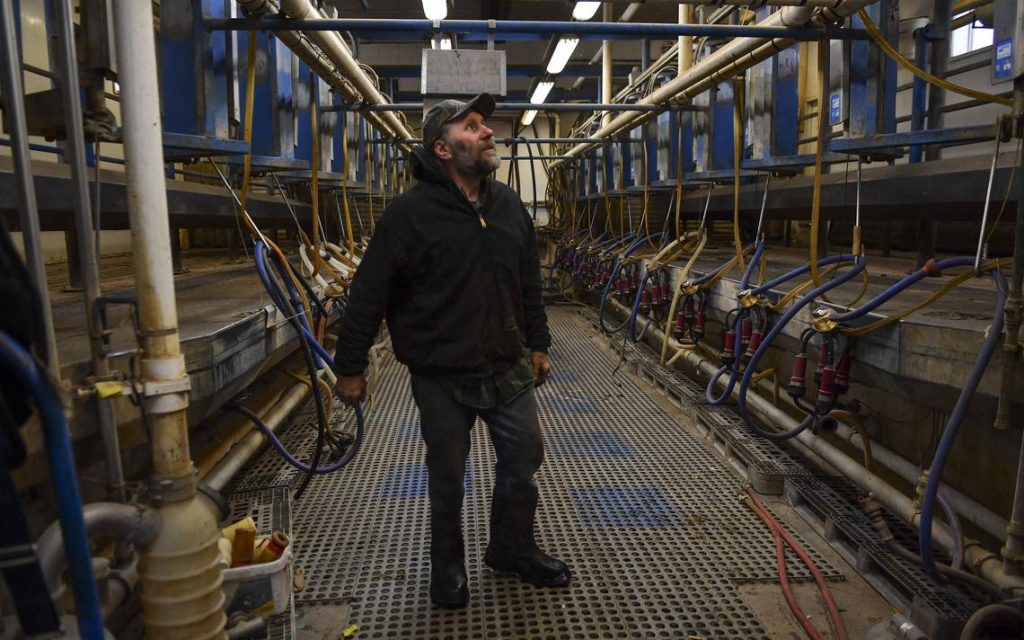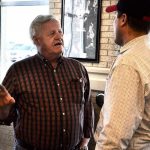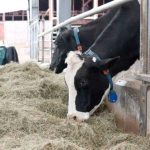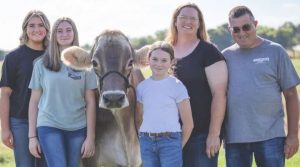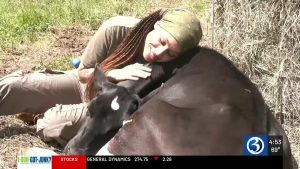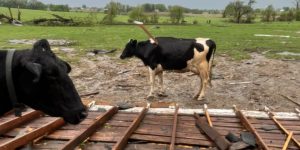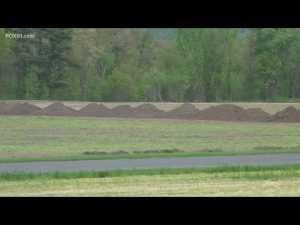
Alfred Krocak came to Minnesota from what is now the Czech Republic and started farming this land in the late 1800s. He followed the rhythms of the seasons and passed on what he knew to his children. The land and hard work sustained generations of Krocaks and all the people who drank millions of gallons of Krocak milk.
Then came last year, and the family had no alternative but to sell off the dairy herd. The debt had become crushing.
Bob and Liz, in their 60s, and their eldest son, Marty, and his wife, Sarah, and their children were one more family in crisis, among the country’s 2 million farms. The historic floods that disrupted the natural cycle of planting, the collapse of milk prices, the tumult of President Donald Trump’s trade wars – it had all come crashing down.
Yet they still had their land. Surely, they could coax something else from it. Spring would come, as it always did.
– – –
Maybe corn and soybeans; that they knew how to grow. More organic crops, a heritage breed of pigs that could bring a higher price per pound. The state farm counselor, whom the Krocaks consulted on their quest to stave off bankruptcy, thought that was a plan. Then the fields flooded and turned to lakes. There were a lot of nights working in the dark, running equipment, fixing this and that. Bob let his 7-year-old grandson Logan watch how to repair the disc harrow for tilling the fields. But the chickens kept laying. Katie, 5, and Daniel, 9, could proudly bring their mother an egg carton that was a paintbox of colors.
Amid the moments of wonder were the hours of worry. Sarah, the rancher’s daughter who fell for her husband in high school, and Marty kept suppertime as family time. But struggle crept in. She worried about her husband. His father, Bob, was an optimist, with a hope in the unseen that most farmers need. Bob got to the point where he could walk around the milking barn again, even though the cows sold for a fraction of what they produced. The fancy pigs were healthy and happy. He loved having his grandchildren close.
But Marty was the fifth generation of Krocaks, the heir to the burden of family and expectations. It was wholly unclear what would work out this time.
RELATED: Farmers fight to save their land in rural Minnesota as trade war intensifies
Liz wasn’t born into a farming family either. She and Bob built a close family. Most of their five kids live nearby, in this part of Minnesota where the winters are wretched and the summers are a golden balm. Dinnertime is a movable feast, with the family gathering for group meals at different homes.
Earlier this year, the family gathered to celebrate the 100th birthday of Bob’s late father, Vladamir, who always wore blue- and white-striped Dickies overalls and carried candy corn in a chewing-tobacco can to hand out to his grandchildren.
At one point, there were more than 200 dairy farmers in Le Sueur County, where the Krocaks live. Now there are just a handful, and Bob says he can see most of them from the top of his silo. More than 300 dairy farmers went out of business in Minnesota last year, part of 2,700 nationwide, according to the U.S. Agriculture Department. That’s a nearly 7% drop.
This spring, the Krocaks were full of practical ideas about coaxing a living out of their land.
Anything that could go wrong did.
It poured, too much too late.
Any time they had a clear night, they planted. The equipment they borrowed didn’t function. They lost $15,000 trying to sell last year’s corn as storms grounded trade routes for grain by rail and the Mississippi River.
The kids made a playhouse out of the hopper.
Summer is another season of opportunity, for a family of optimistic farmers.
And yet.
“Everywhere you turn there’s a new battle,” Liz said. “I’m pretty sure God doesn’t like farmers this year.”
Summer came to Minnesota, and the sun dried the wet fields. The crops struggled to grow, especially the corn, so the whole extended Krocak family took to the fields. Weeding the plants, to give them room to breathe, became one of the most important chores. Marty walked the fields and saw with dismay that in some places the corn was chest high, but other rows came only to his knees.
After historic rain, the Krocaks finally got more than 200 acres planted and began cutting hay to feed their animals for the coming winter. But everything was coming in late, and their next worry, in a season of worries, was that an early frost would cut the growing season at the other end. They weren’t alone; the record-setting rainfall caused a widespread agricultural disaster across the country, preventing nearly 20 million acres of crops from being planted across the country, a record, according to the USDA.
By the end of July, the Krocaks were still waiting for the golden tassels atop their corn to appear.
Some days it seemed like they were well on their way from moving on from their family dairy business, sold last year after a downturn in milk prices left them deeply in debt. Marty and Sarah were determined to help his parents in retirement while making a success of their new farm, growing organic crops and meats – despite the lingering pain from losing the dairy operation, which had been in the Krocak family since 1888.
Marty and Sarah, the next generation of Krocaks to take over the farm, live in the original farmhouse with their four kids – Danny, 9, Ella, 7, Katie, 5 and Delaney, 3. But reminders of the past are everywhere, like the shadow of an old Chevy 1946 truck in the field – nicknamed “Louie” – and the antique butter churn still in place in front of their old “milking parlor.”
After the chaos and long days and nights of planting time, there was time in summer to take a breath and relax, to laze on top of a hay bale at sunset, as granddaughter Eden did one July evening. In late July came the annual Kolacky Days festival, which celebrates their town’s Czech heritage and its famous fruit-stuffed pastry. Marty put on a tux for Friday night’s Kolacky Days pageant – where a queen is chosen and gets a shiny tiara – because this year they honored local farmers.
“Do I pass?” he asked Sarah.
“You look great,” she said, and reached up to straighten his clip-on tie.
Summer also meant it was time to butcher the chickens, part of Sarah’s experiment to expand the farming operation into the sale of organic meat. The former dairy farmers had never butchered so many birds at once – some 100 or so Red Rangers that had free range of the organic farm for months. Danny drove the ATV into the fields as some of the grandkids chased the chickens, scooping them up to deliver them to their fate. After Liz and Sarah lopped off their heads, blood spurted and the still-flopping birds were covered in hot water and run through a plucking machine, then cleaned and packed to be frozen. “What’s inside?” Ella asked, and then got an anatomy lesson from her grandmother.
But the pressure of this make-or-break-year for the farm never seemed to go away. “I got a second chance here, and the bank is sticking with us, and I’m [messing] this up, too,” an exhausted Marty told his parents at one point during the tough planting season. Marty and Sarah had to go back to the bank to ask to extend their operating loan after last season’s corn brought in less money than expected. It was a sobering moment.
The Krocaks keep going because no one can seem to fathom life without the farm. “It’s a great place to raise a family,” Marty tells friends, recalling fondly the way his littlest, Delaney, had no fear when she grabbed and held the biggest Red Ranger of the bunch.
“None of us can contemplate the idea of not being here,” Sarah said, adding somewhat grimly: “So this better work.”
– – –
The air turned crisp and the trees turned fiery against the lush grass. The peppers and squash that survived the wettest spring on record were still on the vine when the blizzard warning came. The forecast called for an unseasonably early two feet of snow in the Dakotas and plummeting temperatures across the north Midwest. A hard frost could endanger the Krocaks’ crops, a potential $30,000 loss. Everybody hurried to prepare, picking the kitchen garden clean and moving livestock fencing, all while listening to the weather report.
Snow came, lacing the fields in white. Danny hit his mother with the first snowball of the season as the Krocaks traipsed through the corn rows early one morning, surveying the damage. They had hoped for a few more weeks of good weather to let the crop mature.
It was good news: Sarah let out a whoop after she peeled back the husks and saw the tell-tale “black layer” mark on the kernels, an indicator that the cob had matured. Most of their corn would survive.
“That’s a relief! I think I’m finally excited for harvest now,” she said. “It’s like one thing that might be OK.”
Before harvest could begin, there were so many chores to be done, with Marty so stressed he jogged from task to task. “Historic” cold and snow in early October: another cruel and unexpected deadline for a family already fighting to save its farm. Marty and Sarah brought the cattle they kept after selling the dairy herd back from a far pasture for the winter.
Harvest was long and brutal. They worked past night many nights. Exhaustion stole over everyone.
The kids helped when they could, climbing up into the grain bin in darkness one evening to help level the soybeans so they could dry evenly. One night, oblivious to the cold, Marty and Danny napped in the tractor cab as they waited for another load of corn to unload from the combine.
The fields stretched to St. John’s Catholic Church and cemetery, where four generations of Krocaks are buried, a constant reminder of the family’s deep roots in this land.
As the long days and nights ran together, tension rose. Marty, Sarah and Bob argued over the best way to go about their massive undertaking: which acres of corn and soybeans to harvest in what order. The argument was a bit of an epiphany for Bob in this first season after fully turning over the farm’s operations to his eldest.
“You know, Marty is a good son, and Sarah is a good daughter-in-law,” Bob said later. “I just need to realize I’m not in charge anymore.”
On Nov. 6, the snow came in earnest, beautiful but ominous, a harbinger of the hard winter ahead.
Some of the corn was still too wet to sell, but they caught a break. A neighboring farmer said he’d buy it out of the field, to chop and feed to his herd.
The soybeans were fine, but would the corn fetch a decent enough price? Would the harvest be enough to pay back their loans and to sustain the family through the coming year?
– – –
By year’s end, wintry cold became the one constant, and much else remained precarious. The family discovered that, with everything they had to do, nobody had time to chop or gather wood for the boiler that heats the farmhouse and workshop. Bob and his four boys spent a blissful day after Thanksgiving gathering wind-fallen trees from a pasture, enough oak and ash and basswood and maple to burn for nearly two months. When another storm threatened, Bob rushed to put the wood through the chopper, stopping to rest only when he was out of breath.
The past year has been hard on Bob. He has continued to struggle with feelings of failure after losing the dairy herd in 2018. “Things didn’t go right for us, and it’s a big change for me, especially because I did it all my life,” Bob said. “I’m still not over it.”
But he realizes as well that there is more to life than dairy farming, notably his sprawling, loving and healthy family. Bob and Liz welcomed their 11th grandchild in May – little Sierra, the first child for his second-to-youngest son, Bobby.
The younger generation of Krocaks running the farm, Marty and Sarah, continued to juggle farm, family and work. Marty had taken a day job at an equipment manufacturer, and that was an adjustment. One afternoon, Delaney and her mother went to the window to watch for him to come home.
Marty and Sarah waited anxiously to meet with their financial counselor and get a final verdict on the year. Farmers across the country had bad seasons, combating low crop prices, record weather and the continued effects of Trump’s trade war with China, which played havoc on exports. The Krocaks were no exception. Their straggly corn hadn’t fetched as good a price at market as they had hoped. In the end, when they ran the numbers, they were in the hole $50,000.
It was a blow – especially for Marty, who, like his father, began struggling with feelings of failure anew.
Instead of enjoying the holidays, they were faced with putting a crisis plan in place. “Everything must go,” said Sarah, at least as far as the cattle was concerned. The Angus beef herd they had hoped to raise for custom steaks now had to be sold, at a time when beef prices were down. Marty has a talent for custom repair work, and he thought he could take on some of that. But he was so overworked already.
The Krocaks had adhered to their budget, tried to do everything right. Bob had worriedly tracked the precipitation the old-fashioned way, with pen to paper, reading his rain gauge daily. In the end, it was the historic rainfall, the wettest year on record in that part of Minnesota, that had doomed them. It delayed the corn planting, complicating the plant’s maturity and the harvest.
“We were hopeful for a decent crop to take the pressure off Marty and Sarah,” Liz said. “That just didn’t happen. It was a very bad year. I’ve talked to so many farmers who say this was the worst year they have ever had. Prices are bad; the weather was a struggle. Everything was a struggle.”
Larger questions were still unanswered. They still carried some $1.3 million in debt from the dairy operation. Would they have to declare bankruptcy on the farm and begin selling some of their land?
And would Sarah and Marty, trying to keep the farm going for the next generation, be able to get another operating loan for their organic crop operation? They wouldn’t find out until spring.
“You think: ‘I’ll do the right things and put the work in and it will work out,’ and when it doesn’t, that’s hard. But there’s always hope,” Sarah said. “Farmers are the biggest gamblers you’ll ever come across.”
In early December, the entire family went to the torchlight parade down the main street in downtown Montgomery, the kickoff for the Christmas season. It was a beautiful night. Santa arrived on top of a fire truck. Fireworks colored the dark sky.
Back home, work beckoned. Chores on the farm wouldn’t stop just because of troubled finances, especially through the cold months. The pigs, chickens and the Welsh pony named Dixie still had to be sheltered and kept warm. There was always more to do, to keep the home fires burning.
This is article was written by Annie Gowen, a reporter for The Washington Post.
